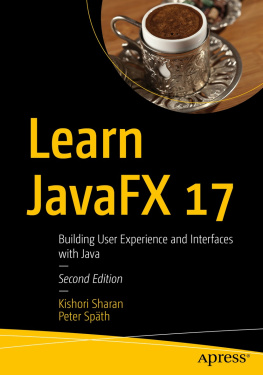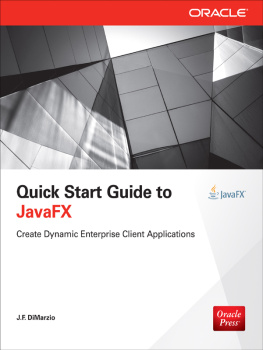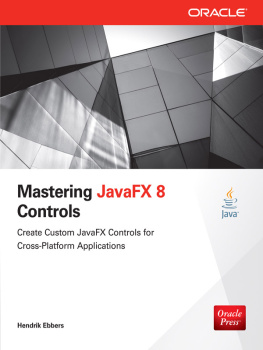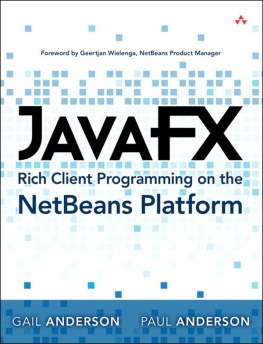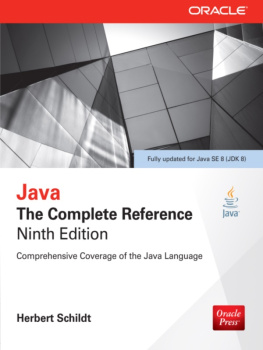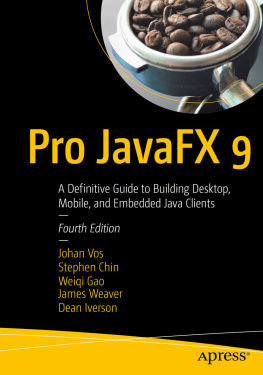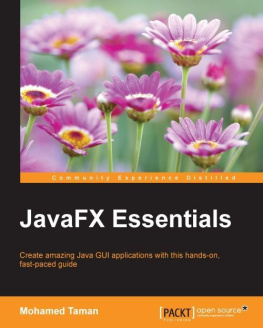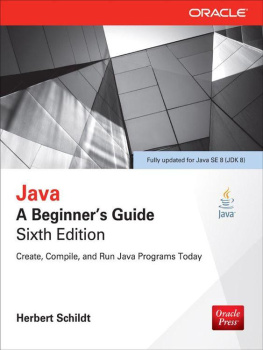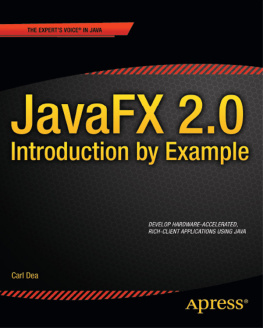About the Author
Best-selling author Herbert Schildt has written extensively about programming for three decades and is a leading authority on the Java language. His books have sold millions of copies worldwide and have been translated into all major foreign languages. He is the author of numerous books on Java, including Java: The Complete Reference, Java: A Beginners Guide, Herb Schildts Java Programming Cookbook, and Swing: A Beginners Guide. He has also written extensively about C, C++, and C#. Although interested in all facets of computing, his primary focus is computer languages. Schildt holds both graduate and undergraduate degrees from the University of Illinois. He can be reached at his consulting office at (217) 5864683. His website is www.HerbSchildt.com.
About the Technical Editor
Gerrit Grunwald is a software engineer with more than ten years of experience in software development. He has been involved in Java desktop application and controls development. Gerrit is interested in Java-driven embedded technologies based on JavaSE and JavaME. He is a true believer in open source and has participated in popular projects like JFXtras.org as well as his own projects (Enzo, SteelSeries Swing, and SteelSeries Canvas). Gerrit is an active member of the Java community, where he founded and leads the Java User Group Mnster (Germany), co-leads the JavaFX and IoT community, and is a JavaOne Rock Star and Java Champion. He is a speaker at conferences and user groups internationally and writes for several magazines.

Copyright 2015 by McGraw-Hill Education (Publisher). All rights reserved. Except as permitted under the United States Copyright Act of 1976, no part of this publication may be reproduced or distributed in any form or by any means, or stored in a data base or retrieval system, without the prior written permission of the publisher.
ISBN: 978-0-07-184256-3
MHID: 0-07-184256-X
The material in this eBook also appears in the print version of this title: ISBN: 978-0-07-184255-6, MHID: 0-07-184255-1.
eBook conversion by codeMantra
Version 1.0
All trademarks are trademarks of their respective owners. Rather than put a trademark symbol after every occurrence of a trademarked name, we use names in an editorial fashion only, and to the benefit of the trademark owner, with no intention of infringement of the trademark. Where such designations appear in this book, they have been printed with initial caps.
McGraw-Hill Education eBooks are available at special quantity discounts to use as premiums and sales promotions or for use in corporate training programs. To contact a representative, please visit the Contact Us page at www.mhprofessional.com.
Oracle and Java are registered trademarks of Oracle Corporation and/or its affiliates. All other trademarks are the property of their respective owners, and McGraw-Hill Education makes no claim of ownership by the mention of products that contain these marks.
Screen displays of copyrighted Oracle software programs have been reproduced herein with the permission of Oracle Corporation and/or its affiliates.
Information has been obtained by Publisher from sources believed to be reliable. However, because of the possibility of human or mechanical error by our sources, Publisher, or others, Publisher does not guarantee to the accuracy, adequacy, or completeness of any information included in this work and is not responsible for any errors or omissions or the results obtained from the use of such information.
Oracle Corporation does not make any representations or warranties as to the accuracy, adequacy, or completeness of any information contained in this Work, and is not responsible for any errors or omissions.
TERMS OF USE
This is a copyrighted work and McGraw-Hill Education and its licensors reserve all rights in and to the work. Use of this work is subject to these terms. Except as permitted under the Copyright Act of 1976 and the right to store and retrieve one copy of the work, you may not decompile, disassemble, reverse engineer, reproduce, modify, create derivative works based upon, transmit, distribute, disseminate, sell, publish or sublicense the work or any part of it without McGraw-Hill Educations prior consent. You may use the work for your own noncommercial and personal use; any other use of the work is strictly prohibited. Your right to use the work may be terminated if you fail to comply with these terms.
THE WORK IS PROVIDED AS IS. MCGRAW-HILL EDUCATION AND ITS LICENSORS MAKE NO GUARANTEES OR WARRANTIES AS TO THE ACCURACY, ADEQUACY OR COMPLETENESS OF OR RESULTS TO BE OBTAINED FROM USING THE WORK, INCLUDING ANY INFORMATION THAT CAN BE ACCESSED THROUGH THE WORK VIA HYPERLINK OR OTHERWISE, AND EXPRESSLY DISCLAIM ANY WARRANTY, EXPRESS OR IMPLIED, INCLUDING BUT NOT LIMITED TO IMPLIED WARRANTIES OF MERCHANTABILITY OR FITNESS FOR A PARTICULAR PURPOSE. McGraw-Hill Education and its licensors do not warrant or guarantee that the functions contained in the work will meet your requirements or that its operation will be uninterrupted or error free. Neither McGraw-Hill Education nor its licensors shall be liable to you or anyone else for any inaccuracy, error or omission, regardless of cause, in the work or for any damages resulting therefrom. McGraw-Hill Education has no responsibility for the content of any information accessed through the work. Under no circumstances shall McGraw-Hill Education and/or its licensors be liable for any indirect, incidental, special, punitive, consequential or similar damages that result from the use of or inability to use the work, even if any of them has been advised of the possibility of such damages. This limitation of liability shall apply to any claim or cause whatsoever whether such claim or cause arises in contract, tort or otherwise.

Contents

Preface
S ince its original 1.0 release, Java has been an innovative force that has driven both the art and science of programming forward. Although it has now been several years since that initial release, Java remains vibrant and alive, constituting what is arguably the worlds most important computer language. One reason for Javas long-term success has been its ability to adapt to the many and varied changes that have occurred in the realm of computing. As you will see in the course of this book, JavaFX 8 carries forward this rich legacy of innovation.
JavaFX is Javas next-generation graphical user interface (GUI) framework. Not only does JavaFX provide a rich, powerful, flexible framework, it is also easy to use. Thus, if you have programmed in one of Javas previous GUI frameworks, such as Swing, you will be pleasantly surprised by how easy it is to create a GUI with JavaFX. Perhaps more importantly, JavaFX gives you features that let you add the visual sparkle that is so crucial to the success of modern applications. In short, JavaFX represents the future of GUI programming in Java. It is truly that important. The goal of this book is to present in a fast-paced manner, the fundamentals of JavaFX programming.
At the time of this writing, the latest version of JavaFX is JavaFX 8. JavaFX 8 was released with JDK 8, and this is the version of JavaFX described in this book. Therefore, as a general rule, when the term JavaFX is used in this book, it refers to JavaFX 8.


